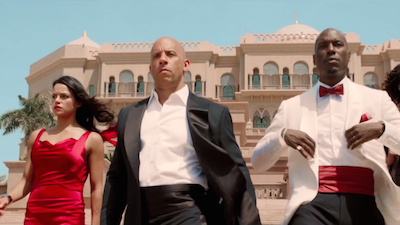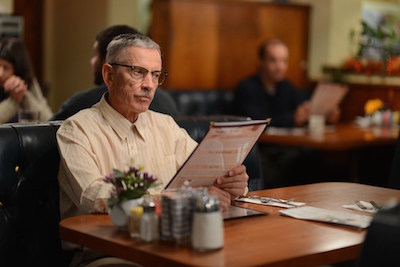 “Cars don’t fly,” Brian (Paul Walker) tells his son early on in Furious 7, which caps, if not concludes, the boxoffice phenomenon revved up by The Fast and the Furious (2001). That is, of course, a joke–shiny, expensive cars spend more time airborne in one of these shows than they ever do on pavement, hurtling off mountaintops and crashing from skyscraper to skyscraper in earsplitting Dolby surround. It’s all in a day’s work, no biggie, for our heroes when they simply crash head on into the bad guys on the street.
“Cars don’t fly,” Brian (Paul Walker) tells his son early on in Furious 7, which caps, if not concludes, the boxoffice phenomenon revved up by The Fast and the Furious (2001). That is, of course, a joke–shiny, expensive cars spend more time airborne in one of these shows than they ever do on pavement, hurtling off mountaintops and crashing from skyscraper to skyscraper in earsplitting Dolby surround. It’s all in a day’s work, no biggie, for our heroes when they simply crash head on into the bad guys on the street.
Offscreen, however, a car recklessly driven can be lethal. Exit Paul Walker, another member of that sad fraternity of actors survived by posthumous credits. Brian spends a lot of time contemplating his mortality in his unexpected departure from the series, in one uncomfortable scene in a cemetery. Buzzkill. Morbid undercurrents, as it happens, are a specialty of director James Wan, newly installed in the driver’s seat after the horror hits Saw, Insidious, and The Conjuring. But Wan rushes past them; this franchise is not for brooding, and the accent is on making Furious Seven (the onscreen title, as opposed to the “branded” one) faster, more furious, and louder than the six before it.
Which means, of course, piling on the cars, the action, and the gloss, making it stupider. It’s the rare series that gets smarter as it goes along, or adapts in some intriguing way, and these films are content to age in place, getting fatter and lazier. Funny thing, though–audiences, and some critics, don’t seem to mind. Since 2009’s fourth installment, which marked the full-time return of Vin Diesel, each new entry has gained substantially in gross, and affection among reviewers who knock the Transformers movies for the same idiot scripting and pile-ups of dopey, CGI-fueled setpieces. I’m not immune to it myself. So what’s the appeal?
 “Family,” says Diesel, once, twice, 300 times, plugging the “heart” element of the product line. We’ve grown to love, or like, or at least kind of accept the big lug and his multiethnic team, however thin and synthetic their characterizations, and we root for them while hooting at implausibilties that torpedo most sequels. The seven have a lot to be furious about this time. Dom (Diesel) and Hobbs (Dwayne Johnson) are furious that someone is trying to blow all of them up; Deckard (Jason Statham), the perp, is furious that they put his brother in the hospital in part 6. Brian is furious that he’s a stay-at-home dad baffled by how to operate a minivan; wife Mia (Jordana Brewster) is furious that he’s lost his mojo, and pouts from the sidelines. With a scowl that could stop an ISIS member dead in his or her tracks at ten paces, the sort-of amnesiac Letty (Michelle Rodriguez, the Latina Richard Widmark) is furious that she can’t remember if she’s married to Dom, and why he doesn’t just set her straight leads to a groaner of an explanation. Comic relief black guy Roman (Tyrese Gibson) is furious that no one takes him seriously as a leader; comic relief black guy Tej (Ludacris) is randomly furious, sometimes at Ramsey (Nathalie Emmanuel), who has developed a super-sophisticated “biomapping” system called God’s Eye, yet is mostly ogled by the guys, and the camera, for her hotness. Courtesy of Deckard’s scheming (I think; the two halves of the thriller mechanics never quite sync), Ramsey goes missing, and a government operative, Mr. Nobody (Kurt Russell), puts the team on her tail. Pleased to be in a movie that will likely outgross all of his beloved cult 80s hits (Used Cars, Big Trouble in Little China, etc.) by Saturday afternoon, Russell is too cool to be furious. Along for the ride are Sean (Lucas Black), from the 2006 series outlier Tokyo Drift (the quintessential “third part” that changed the rules, according to Scream), Gal Gadot, the future Wonder Woman, and furious supplementary villains Tony Jaa (who figures in one wittily conceived action scene) and Djimon Hounsou.
“Family,” says Diesel, once, twice, 300 times, plugging the “heart” element of the product line. We’ve grown to love, or like, or at least kind of accept the big lug and his multiethnic team, however thin and synthetic their characterizations, and we root for them while hooting at implausibilties that torpedo most sequels. The seven have a lot to be furious about this time. Dom (Diesel) and Hobbs (Dwayne Johnson) are furious that someone is trying to blow all of them up; Deckard (Jason Statham), the perp, is furious that they put his brother in the hospital in part 6. Brian is furious that he’s a stay-at-home dad baffled by how to operate a minivan; wife Mia (Jordana Brewster) is furious that he’s lost his mojo, and pouts from the sidelines. With a scowl that could stop an ISIS member dead in his or her tracks at ten paces, the sort-of amnesiac Letty (Michelle Rodriguez, the Latina Richard Widmark) is furious that she can’t remember if she’s married to Dom, and why he doesn’t just set her straight leads to a groaner of an explanation. Comic relief black guy Roman (Tyrese Gibson) is furious that no one takes him seriously as a leader; comic relief black guy Tej (Ludacris) is randomly furious, sometimes at Ramsey (Nathalie Emmanuel), who has developed a super-sophisticated “biomapping” system called God’s Eye, yet is mostly ogled by the guys, and the camera, for her hotness. Courtesy of Deckard’s scheming (I think; the two halves of the thriller mechanics never quite sync), Ramsey goes missing, and a government operative, Mr. Nobody (Kurt Russell), puts the team on her tail. Pleased to be in a movie that will likely outgross all of his beloved cult 80s hits (Used Cars, Big Trouble in Little China, etc.) by Saturday afternoon, Russell is too cool to be furious. Along for the ride are Sean (Lucas Black), from the 2006 series outlier Tokyo Drift (the quintessential “third part” that changed the rules, according to Scream), Gal Gadot, the future Wonder Woman, and furious supplementary villains Tony Jaa (who figures in one wittily conceived action scene) and Djimon Hounsou.
Other than some inventive, gamer-type camerawork in an early bout between Deckard and Hobbs, there’s not much new here, other than the cars, used for digitized acrobatics that Pixar wouldn’t stoop to. And the connective tissue that gets them from point A, parachuting onto a hazardous roadway in the Caucasas, to point B, a trio of skyscrapers in Abu Dhabi, is, to put it mildly, flimsy. After the Eurasian adventure we’re asked to believe that a friend of Ramsey’s has sold the prized God’s Eye to a partying billionaire in a fab penthouse high above the emirate, cueing the next round without so much as a blink of an eye from the crew. Little is left for the climax, set in a collapsing parking garage, which has to be another joke. No one parks a car in a Fast and Furious movie, preferring to drive them off mountains to burst into flame. That’s what I’m doing with my ten-year-old Acura.
Then again these movies are all climaxes (with squealing tires and clashing metal the orgasms) and have been since the more modest first, which built up genuine, Point Break-style tension between Dom and Brian, then on opposite sides of the law. What we’ve come to see, frankly, is what kind of sendoff Walker will get, as the “Brian years” of the franchise come to a screeching halt. Credit due a series that runs on manufactured rather than genuine emotion, it’s genuinely touching, giving its many fans a reason to applaud. For a few minutes I felt like I was part of the family.
 Scott Glenn could use a fast and furious career tuneup. Like Russell, he’s the kind of veteran actor who adds class and distinction by his very presence, and, like Russell, he’s spent chunks of his career idling. Judging from the IMDb he looks to be prominent on Netflix’s Daredevil for a few episodes, which justifies the time spent streaming. While we wait, you can catch him as The Barber, in a few theaters and on VOD.
Scott Glenn could use a fast and furious career tuneup. Like Russell, he’s the kind of veteran actor who adds class and distinction by his very presence, and, like Russell, he’s spent chunks of his career idling. Judging from the IMDb he looks to be prominent on Netflix’s Daredevil for a few episodes, which justifies the time spent streaming. While we wait, you can catch him as The Barber, in a few theaters and on VOD.
This is a serial killer job, not bad if nothing special, which he uplifts. His smalltown barber, Eugene, lives quietly, and primly, in a small town, berating his assistant for cursing. His applecart is upset by John (Chris Coy), the son of a policeman who investigated him decades earlier. Eugene was once Francis, and Francis was a suspect in multiple killings in Chicago, committed by a killer who liked to bury his pretty victims alive. John’s father tampered with evidence to convict Francis, a ploy that backfired. But John isn’t seeking revenge; rather, he wants to learn the art of killing from his father’s nemesis. Things get dark–then, I’m afraid, murky, as muddled twists pile up like so many tangled corpses over 90 minutes.
Interestingly, The Barber is the first movie produced by Orange County-based Chapman University, and rather than output something warm and fuzzy the faculty let students like director Basel Owies and writer Max Enscoe fly their freak flag. Not high enough, however, as there’s little here to make this stand out amidst a dozen or so like offerings on demand. The reliable Stephen Tobolowsky’s in it, too, sharing scenes with Glenn, who looks every bit of his 74 years in the beginning, then relaxes into his character’s real skin as some very close shaves begin.





Comments